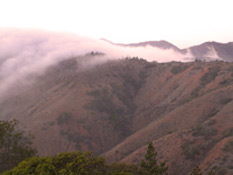Grad student Park Williams, who is currently doing climate/fog/biogeography research on Santa Rosa Island, sent the following:
I was one of 10 students who did talks or presentations at the Biogeosciences session of the Fall AGU (American Geophysical Union) meeting in San Francisco to receive an Outstanding Student Paper Award. The award was announced in the April 17 2007 edition of the EOS newsletter (Vol. 88, No. 16). My poster was titled ‘Teasing foggy memories out of pines using tree-ring width and stable isotope approaches’. The poster can be viewed at https://legacy.geog.ucsb.edu/~williams/2006_AGUposter.pdf.
On the poster, Chris Still, Doug Fischer, Steve Leavitt (University of Arizona), and I show that Torrey pines on nearby Santa Rosa Island experience relatively more growth during years with frequent summertime cloud cover, known locally as “June Gloom.” We discovered this, because Torrey pines contain a clear record of annual summertime fog and stratus-cloud cover, in addition to a record of annual winter rainfall, in their tree-ring widths. Joel Michaelsen and others have previously shown coniferous trees in more inland areas of central and southern California to document very accurate records of annual rainfall totals, but the discovery of a significant effect of cloud cover on ring widths, independent of any effect of rainfall, is the first of its kind. While populations of conifers such as Bishop pines, Douglas firs, and coast Redwoods once existed much more uniformly along California’s coast during the previous ice age, species distributions have crept northward and towards the coast in response to increased drought stress during the transition to interglacial, warmer conditions in the past several thousand years. This research provides evidence that the few remaining pockets of conifers growing at the southern extent of their species ranges have been helped along through this non-ideal transition to a warmer and drier Mediterranean climate by abnormally frequent summertime fog and cloud cover that provides much-needed water and shading during the rainless summer months. My future Ph.D. work will include using stable isotopic chemistry of vegetation and satellite imagery of daily cloud cover over the United States’ west coast to further test this hypothesis.
Kudos to Park for his award, his research, and his brilliant poster title!




